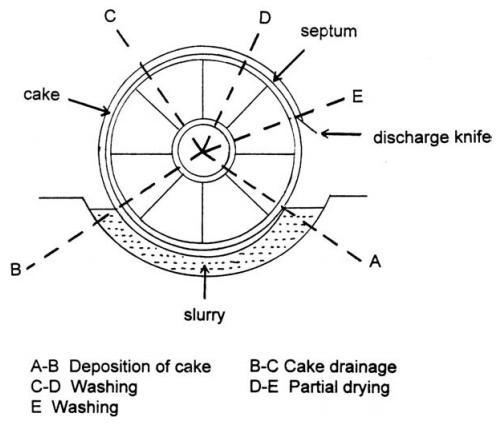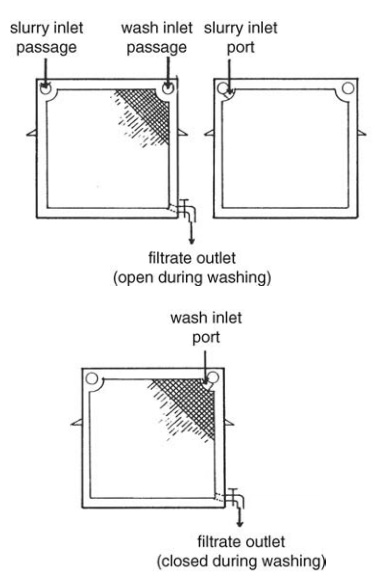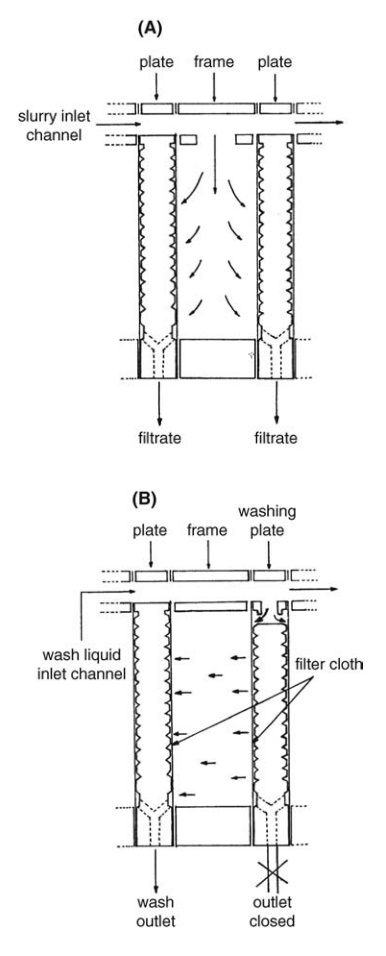Filters
| Home | | Pharmaceutical Technology |Chapter: Pharmaceutical Engineering: Filtration
The method by which filtrate is driven through the filter medium and cake, if present, may be used to classify filters. Four groups may be listed: gravity filters, vacuum filters, pressure filters, and centrifuge.
FILTERS
The
method by which filtrate is driven through the filter medium and cake, if
present, may be used to classify filters. Four groups may be listed: gravity
filters, vacuum filters, pressure filters, and centrifuge.
Each
group may be further subdivided into filters employed in either continuous or
batch processes, although, because of technical difficulties, continuous
pressure filters are uncommon and expensive. The general principles of each
group are discussed below. These principles are illustrated by several widely
used filters. More extensive surveys can be found in the literature (Salter and
Hosking, 1958; Dickey, 1961).
Gravity Filters
Gravity
filters employing thick, granular beds are widely used in municipal water
filtration. However, the low operating pressures, usually less than 1.03 x 104 N/m2, give low
rates of filtration unless very large areas are used. Their use in pharmacy is
very limited. Gravity filters using suspended media composed of thick felts are
sometimes used for clarification on a small scale. On a somewhat larger scale,
a wooden or stone tank, known as a nutsche, is used. The nutsche has a false
bottom. This may act as the filter medium, although, more com-monly, the bottom
is dressed with a cloth. The slurry is added, and the material filters under
its own hydrostatic head. The filtrate is collected in the sump beneath the
filter. Thorough washing is possible either by simple displacement and
diffusion or by resuspending the solids in a wash liquid and refiltering. The
nutsche is comparatively difficult to empty, and labor costs are high.
Vacuum Filters
Vacuum
filters operate at higher pressure differentials than gravity filters. The
pressure is limited naturally to about 8.27 x 104 N/m2,
which confines their use to the deposition of fairly thin cakes of freely
filtering materials. Despite this limitation, the principle has been
successfully applied to continuous and com-pletely automatic cake filtration
for which the rotary drum filter is most extensively used.
The
rotary drum filter is illustrated in Figure 11.3. A typical construction may be
regarded as two concentric, horizontal cylinders, the outer cylinder being the
septum with a suitable perforated metal support. The annular space between the
cylinders is divided by radial partitions producing a number of peripheral
compartments running the length of the drum. Each compartment is connected by a
line to a port in a rotary valve, which permits the intermittent application of
vacuum or compressed air as dictated by the different parts of the filtration
cycle. The drum is partially immersed in a bath to which the slurry is fed. The
complete cycle of filtration, washing, partial drying, and discharge is
completed with each revolution of the drum and usually takes from one to ten
minutes. The relative length of each part of the cycle, indicated by the segments
superimposed on the figure, will depend on the cake-forming characteristics of
the slurry and the importance of the associated operations of washing and

FIGURE 11.3 Rotary vacuum filter.
drying.
They may be varied by the depth of immersion and the speed of rotation so that
each compartment remains submerged for sufficient time for the for-mation of an
adequate cake. Washing and dewatering can be carried out to the standard
required during the remaining part of the cycle. The slurry must be effectively
agitated during operation, or else sedimentation will cause the preferential
deposition of the finer particles, giving a cake of low permeability.
Agitation, of course, must not erode the deposited cake. Maintaining a sus-pension
of very coarse particles therefore becomes difficult or impossible, and other
methods of feeding must be adopted.
Filtration
may be followed by a brief period of draining in which air is drawn through the
cake, displacing retained filtrate. Washing is usually carried out with sprays,
although devices that flood the cake have been used. Dewatering, again achieved
by drawing air through the cake, is followed by discharge. A scraper knife,
assisted by compressed air, which causes the septum to belly against the
cutting edge, is commonly used. Highly cohesive cakes, such as those
encountered in the removal of mycelial growth from antibiotic cultures, may be
removed by means of a string discharge. A series of closely spaced, parallel
strings run on the cloth around the drum. At the discharge section, the strings
lift the cake away from the cloth and over a discharge roller after which the
strings are led back to the drum.
Other
variants of rotary drum filtration include top feed filtration and precoat filtration.
As already mentioned, slurries containing coarse particles cannot be
effectively suspended by the method described above. Such materials, which give
rapid cake formation and fast dewatering, may be filtered by applying the
slurry to the top of the drum using a feed box and suitable dams.
Sedimentation, in this case, assists filtration.
Precoat
filtration using a rotary drum is applied to slurries that contain a small
amount of fine or gelatinous material, which plugs and blinds the filter cloth.
Filtration is preceded by the deposition of a filter aid on the drum to a depth
of up to 4 in. Blinding of the surface layers occurs during filtration, but
these layers are removed at the discharge section by a slowly advancing knife
so that a clean filtering surface is continually presented to the slurry. The
depth of the cut depends on the penetration of the precoat by the slurry solids
and is usually of the order of a hundred-thousandth of a meter. This method has
allowed the filtration of slurries that could not previously be filtered or
that demanded the addition of large quantities of a filter aid.
For
filtration on a smaller scale, the nutsche is used. A vacuum is drawn on the
sump of the tank, giving a much faster filtration rate than that in a gravity-operated
process.
Pressure Filters
Because
of the formation of cakes of low permeability, many slurries require higher
pressure differentials for effective filtration than that can be applied by
vacuum techniques. Pressure filters are used for such operations. They may also
be used when the scale of the operation does not justify the installation of
continuous rotary filters. Usually, operational pressures of 6.89 x 104
to 6.89 x 105 N/m2 are applied across stationary filter
surfaces. This arrangement pro-hibits continuous operation because of the
difficulty of discharging the cake while the filter is under pressure. The
higher labor costs of batch operation are, however, offset by lower capital
costs.

FIGURE 11.4 The filter press: plates and
frame. (A) Filter plate, (B) frame, and (C) washing plate.
The
most commonly used pressure filter is the plate and frame filter press. It
consists of a series of alternating plates and frames mounted in line on bars,
which provide support and facilitate assembly and cake discharge. Typical
plates and frames are shown in Figure 11.4.
The
filter cloth is mounted on the two faces of each plate, and the press is
assembled by moving the plates and frames together with a hand screw or hydraulic
ram. This provides a series of compartments, the peripheries of which are
sealed by the machined edges of the plates and frames uniting on the filter
cloth, which acts as a gasket. Dripping often occurs at this point, so the
press is less suitable for noxious materials. The dimensions of each
compartment are determined by the area of the plates and the thickness of the
intervening frame. These dimensions and the number of compartments used depend
primarily on the volume of slurry to be handled and its solids content. The
plate faces are corrugated by grooves or ribs, which effectively support the
cloth, preventing distortion under pressure and allowing free discharge of the
filtrate from behind the cloth. A section of the assembled filter press is
given in Figure 11.5A.
Coincident
holes, shown in the top left-hand corner of both plates and frames, provide, on
assembly, a channel for the slurry and, simultaneously, enter into each
compartment through an entry port in each frame. All compartments, therefore,
behave in the same way with the formation of two cakes on the opposing plate
faces. Discharge of filtrate after passage through cake, cloth, and
corrugations takes place through an outlet in the plate shown diametrically
opposite to the frame entry port. Filtration may be continued until the cake
entirely fills the compartments or the accumulation of cake gives
unsatisfactory rates of filtration.
Washing
may be carried out by simply replacing the slurry by wash liq-uids and
providing for its separate collection. This method, however, gives inefficient
washing due to erosion and channeling of the cake. Where efficient washing is
required, special washing plates alternate with the plates described above.
These contain an additional inlet, which leads the wash liquid in behind the
filter cloth. During washing, the filtrate outlet on the washing plate is
closed so that the wash liquid flows through the cloth and first cake in a
direction opposite to that taken by the filtrate. The wash liquid then follows
the course of the filtrate through the cake and cloth of the opposite plate. A
diagrammatic representation of the flow of liquids during washing is given in
Figure 11.5B.

FIGURE 11.5 The filter press assembled
press showing a frame and two plates. Movement of liquid during (A) filtration
and (B) washing.
The development of
filter media in sheet form with high wet strength and the ability to retain
extremely fine particles extends the application of the plate and frame filter
to clarification. Such media occur in various grades and, when used in
apparatus similar to that described above, may be used to clarify or sterilize
liquids containing a very low proportion of solids. In sterilization by sheet
filtration, the operation is carried out in two stages. The solution is first
clarified. The very clean filtrate is then passed through the sterilizing sheet
under a relatively low pressure. Before the operation, the assembled filter is
sterilized by steam. The washing apparatus, assembled with suitable sheets, may
also be used for air filtration.
Other filters widely
used for clarification are the metafilter and the streamline filter. The former
consists of a large number of closely spaced rings, usually made of stainless
steel, mounted on a rod. The rod is fluted to provide channels for the
discharge of filtrate. The passage of filtrate between the rings is provided by
scallops stamped on one side of each ring and maintains a ring spacing of
between one and eight hundred-thousandths of a meter. This con-struction
provides a robust support for the actual filtering medium. It is mounted in a
suitable pressure vessel, and large filters consist of a number of units. For
clarification, the filter is first coated by circulating filter aid of the
correct grade. The finest materials are suitable for the removal of bacteria.
The coat acts as a depth filter. Filter aids may also be added to the liquid to
be clarified.
The
“streamline” filter employs paper disks compressed to form a filter pack. The
filtrate passes through the minute interstices between the disks, leaving any
solids at the edge. This is the principle of edge filtration. Other filters,
composed of metal plates or wires, operate on the same principle and are used
for coarse clarification.
Many
small-scale filters consist simply of a fixed, rigid medium, robust enough to
withstand limited pressures, mounted in a suitable housing. Such filters, which
are also vacuum operated, are used to clarify by depth filtration. Media are
composed of sintered metals, ceramics, plastics, or glass. Filters prepared
from closely graded and sintered ceramic powders are suitable for the
sterilization of solutions by filtration on a manufacturing scale.
Related Topics
